Key takeaways:
- Understanding reparations requires acknowledging historical injustices and the necessity of collective action for change.
- Building diverse coalitions enhances the fight for reparations by amplifying voices and fostering resilience through shared narratives.
- Effective outreach and personal connection are vital in mobilizing support and transforming interested individuals into passionate advocates.
- Navigating challenges and embracing resistance can strengthen coalitions and deepen connections among members.
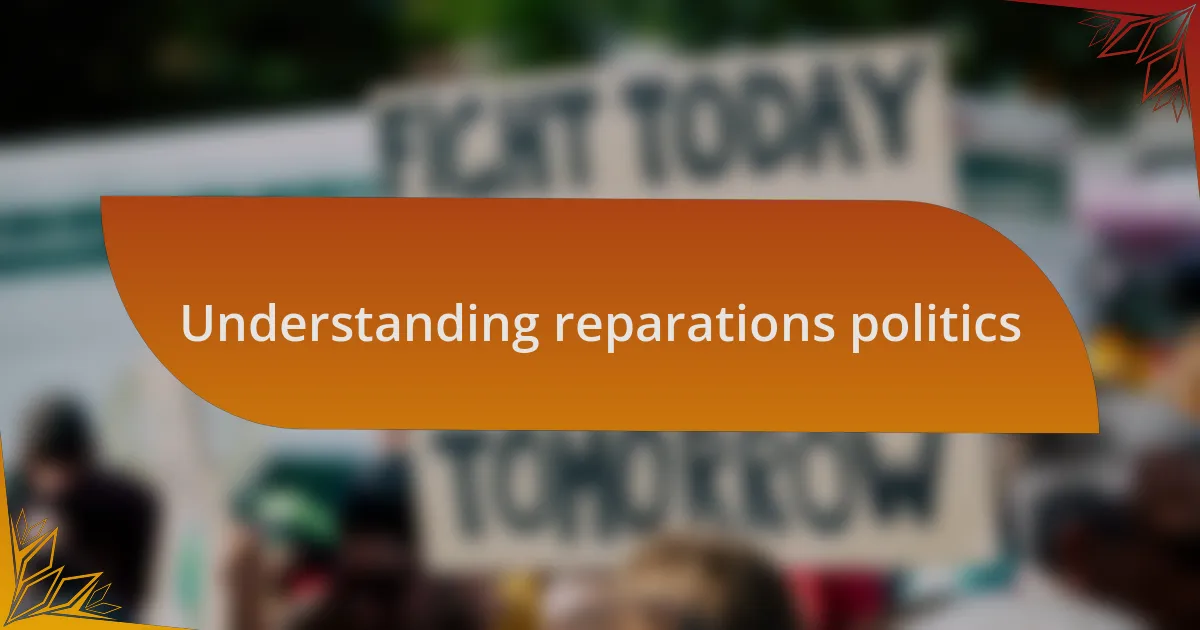
Understanding reparations politics
Understanding reparations politics requires delving into its multifaceted nature. The history of systemic injustices, such as slavery and segregation, has created a profound gap in wealth and opportunity for marginalized communities. When I first began to explore this topic, I couldn’t help but feel a mix of frustration and hope. How can we reconcile so much harm with tangible reparative actions?
Reparations aren’t just about financial compensation; they encompass broader social, political, and economic reforms aimed at addressing historical wrongs. I remember a particular community gathering where a speaker passionately articulated the need for reparative justice as a moral imperative. It struck me—how can we move forward as a society without acknowledging and addressing these historical grievances?
Moreover, unpacking the nuances of reparations politics means engaging with various perspectives and proposed solutions. In my conversations with advocates, I’ve come to appreciate how diverse opinions can enrich the dialogue. Yet, I can’t help but wonder: Can we truly form a coalition for change if we don’t first agree on the need for reparations? It’s a challenging but essential question that demands our attention.
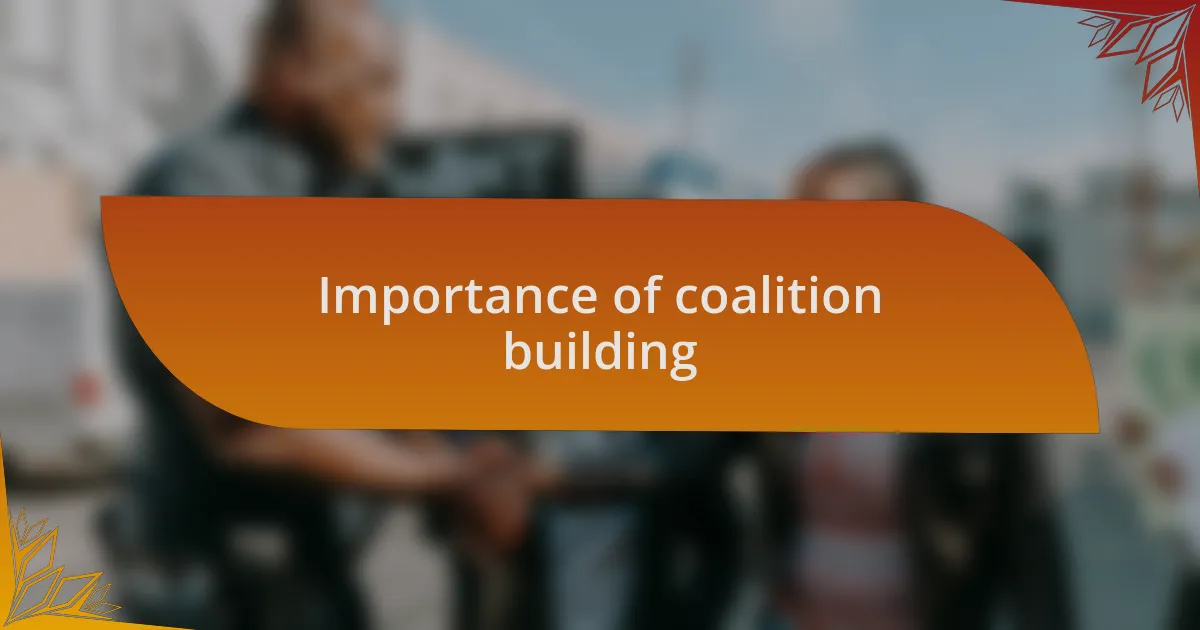
Importance of coalition building
Building coalitions is crucial in the fight for reparations because it amplifies our voices and enhances our collective impact. I recall my early efforts to bring together different community groups—each with unique experiences and stories. It was inspiring to see how our shared goal of justice allowed us to set aside differences and focus on the bigger picture: healing and restoring what was lost.
The diversity within a coalition is not just beneficial; it’s essential. Each member brings their own narratives, which can shine a light on various aspects of the reparations cause that might otherwise go unnoticed. When I sat in a coalition meeting and listened to a young activist share her family’s history, it underscored the urgency behind our mission. How could anyone hear those stories and not feel compelled to act?
Moreover, coalition building fosters resilience. I remember a moment when our group faced significant pushback from local officials, but it was the solidarity among us that fortified our resolve. The strength we derived from each other reminded me that this fight is not just individual—it’s collective. Isn’t that the essence of true change? Without a united front, our efforts would falter, but together, we create an unstoppable force.
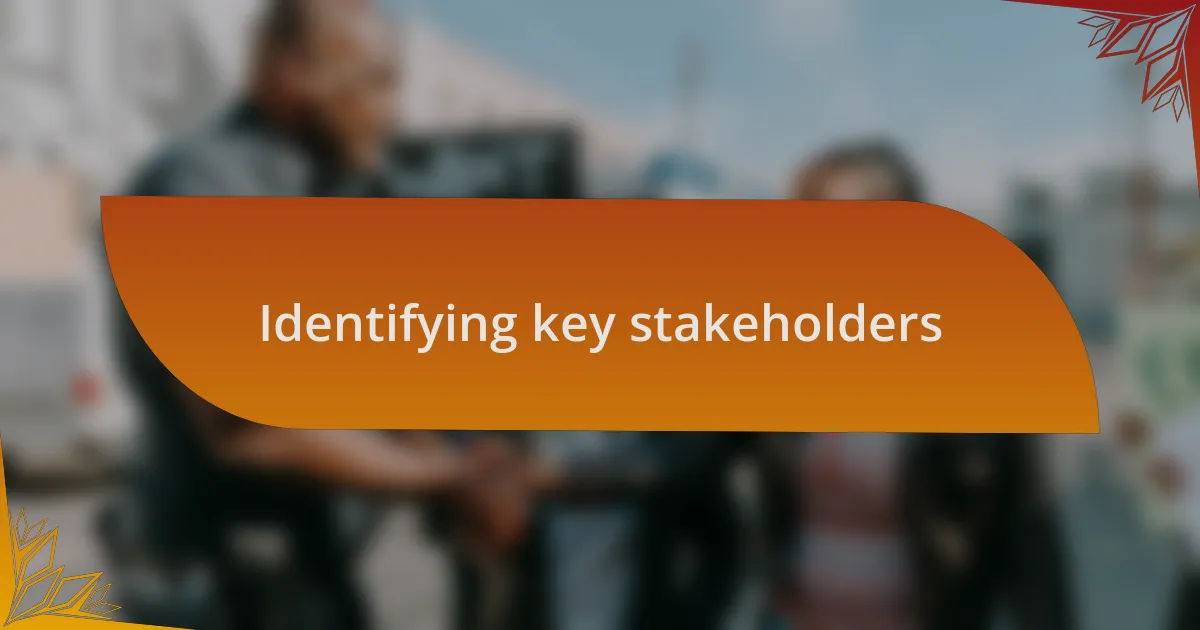
Identifying key stakeholders
Identifying key stakeholders is a critical step in building a successful coalition for change. I vividly remember the first time I mapped out the different groups that could play a role in our movement. From local advocacy organizations to academic institutions and even businesses willing to support reparations, it was eye-opening. Who would have thought that a small community center and a university could have such aligned goals?
As I engaged with these stakeholders, I found that their diverse perspectives enriched our approach. During one impactful meeting, a local business owner shared how their family had directly benefited from systemic inequities, creating a personal connection that fueled our discussions. It made me realize that understanding each stakeholder’s story is essential. How do we leverage these unique narratives to push our message forward?
Ultimately, it’s about building relationships and understanding what motivates each party. I recall an initial reluctance from some stakeholders, thinking reparations were too controversial. By listening, addressing concerns, and highlighting the broader societal benefits, I could see their perspectives shift. Isn’t it fascinating how fostering dialogue can transform skepticism into advocacy? This process not only strengthened our coalition but also ignited a shared passion for justice among all involved.

Strategies for effective outreach
Effective outreach begins with authentically connecting with your audience. I remember hosting a community forum where I shared my personal journey related to reparations. As I opened up about my family’s history, I could see attendees slowly leaning in, their expressions shifting from curiosity to engagement. It made me realize that vulnerability fosters trust. How can we create spaces where stories lead the conversation?
Another key strategy is leveraging digital platforms for wider reach. I recall strategically using social media to share compelling visuals and testimonies that resonated with our cause. During one campaign, a simple video clip of a community member sharing their experience went viral, galvanizing support from unexpected corners. What does it take to craft a message that not only informs but also inspires people to take action?
Lastly, personal follow-ups after initial outreach can make a significant difference. I consistently reached out to people who showed interest during events, checking in to see how they felt about the progress. This practice deepened our relationships, transforming interested individuals into passionate advocates. Isn’t it interesting how a simple gesture of care can turn an idea into a movement?
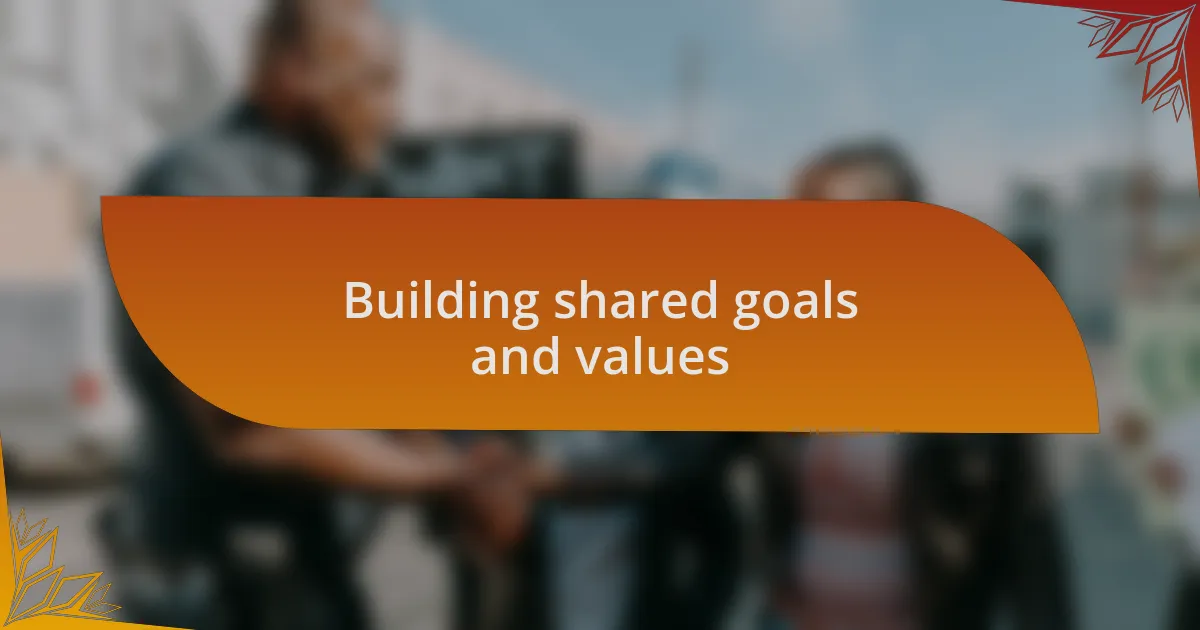
Building shared goals and values
Establishing shared goals and values is pivotal when building a coalition for change. I remember sitting down with diverse community leaders, each bringing their unique perspectives to the table. During those discussions, we focused on finding common ground—not just what divided us but what united us. It struck me how powerful it was to highlight our shared vision for equity and justice. What motivates us, fundamentally, drives the movement forward.
I once participated in a workshop where we collectively defined what reparations meant to us. The varying interpretations were eye-opening, yet the act of listening created a deeper understanding among us. It became clear that while our individual experiences varied, our core belief in healing and justice was a unifying force. How often do we take the time to listen to one another’s stories before jumping into solutions?
As we built this coalition, setting shared goals became both an art and a science. We engaged in numerous brainstorming sessions, employing sticky notes and collaborative tools to visualize our objectives. This hands-on approach turned abstract concepts into tangible goals. I often ask myself, what could we achieve if every participant felt truly invested in the vision we were crafting together? Transforming our goals into a shared narrative solidified our commitment and inspired collective action.
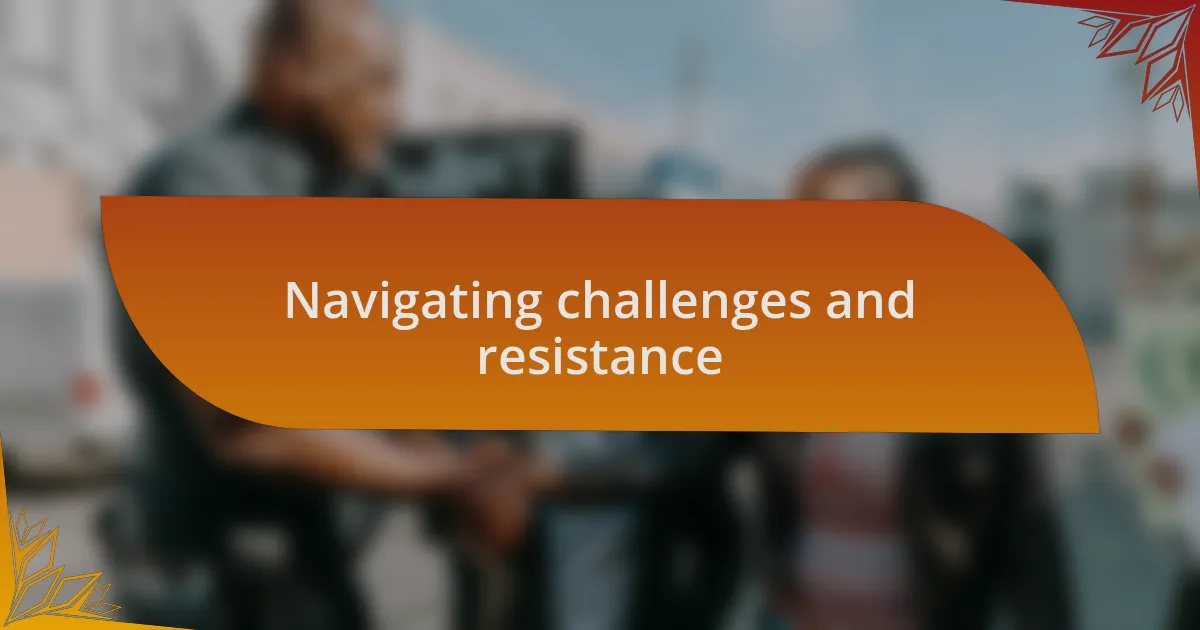
Navigating challenges and resistance
Navigating challenges and resistance is often one of the most daunting aspects of coalition-building. I recall a critical moment when a prominent member of our coalition expressed skepticism about the feasibility of our goals. It felt like a punch to the gut; their doubts surfaced fears I had kept buried. Rather than dismiss their perspective, I chose to engage in a candid discussion. This experience taught me that acknowledging resistance openly can foster a space for constructive dialogue, transforming potential roadblocks into collaborative solutions.
Resistance can manifest in many forms, from internal disagreements to external pressures. One time, we faced pushback from factions within our community who believed our approach didn’t adequately address their specific needs. Instead of viewing this as a setback, we organized a series of listening sessions where everyone could voice their concerns. I vividly remember the moment an impassioned participant shared their story of loss and longing for justice. It reinforced my belief that empathy is a powerful tool; by actively listening, we not only validated their feelings but also reshaped our strategy to be more inclusive.
Ultimately, enduring challenges is not just about overcoming opposition; it’s about embracing it as part of the growth process. I often think, what if we allowed resistance to push us toward deeper connection? Each hurdle we encountered brought us closer as a coalition, reminding me that resilience is not just individual but collective. It’s in this shared struggle that we discovered our greatest strength, turning what could have been divisions into a source of unity.
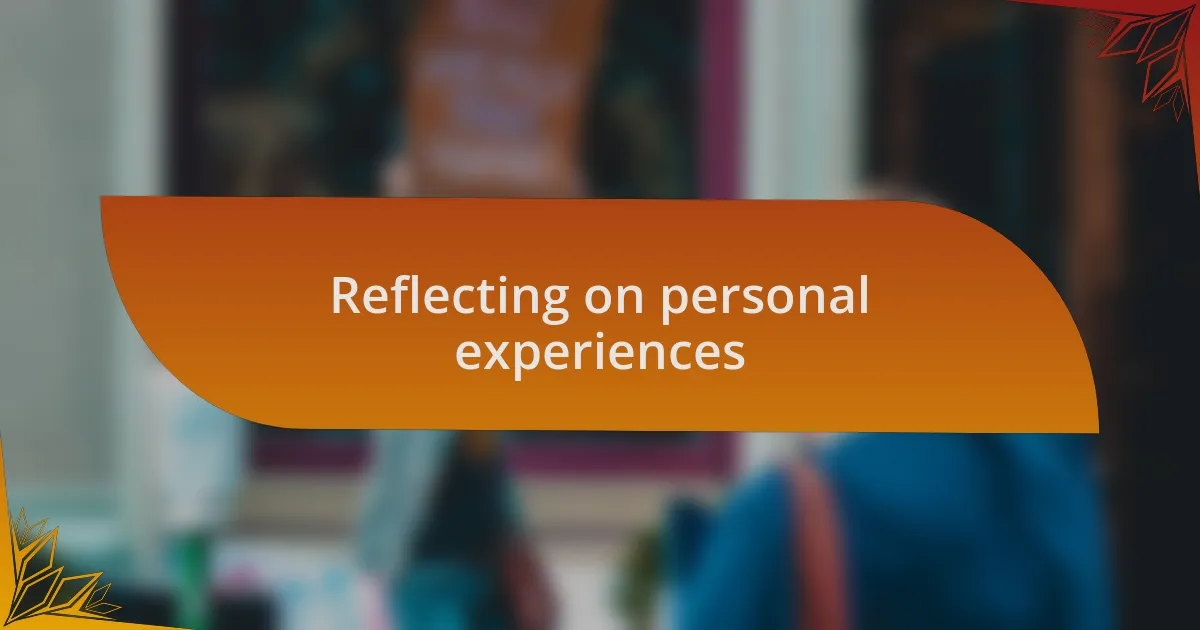
Reflecting on personal experiences
Reflecting on personal experiences often reveals insights that shape our understanding of coalition-building. I remember a time when a late-night phone call from a fellow coalition member left me feeling isolated and overwhelmed. They shared their fears about our momentum dwindling amid external criticism. In that moment, I realized how crucial it is to openly share our vulnerabilities. Our conversation not only strengthened our relationship but also reminded me that honesty can foster resilience.
As I look back, a pivotal experience stands out—a community meeting where I shared my own family’s history with systemic injustice. I could see the hesitation in the room as I opened up about my grandparents’ struggles, and it felt like I was peeling back layers of fear and mistrust. Why was it so hard to share our stories? I learned that personal narratives can bridge divides, creating pathways to connect our individual experiences to collective goals.
There are moments in this journey that linger in my mind, like the time a coalition member spontaneously burst into tears while recounting their experience with discrimination. How do we heal from such deep-rooted pain? This reflection not only illuminated the emotional weight carried by many but also sparked a renewed commitment in our coalition. Embracing our shared vulnerabilities has led us toward a deeper sense of purpose—and that, I believe, is where true change begins.